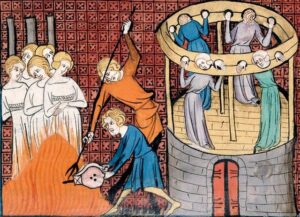
There are two major viewpoints in Christianity regarding priesthood. Though it’s a bit more complex than this, for the sake of simplicity I’ll call them the Catholic view and the Protestant view. Under the Catholic view, ordination matters. Priests are priests because they have been consecrated as priests by someone who has been consecrated by someone who has been consecrated, etc., and priests have power and authority to do things that regular people don’t. Under the Protestant view, ordination isn’t as big of a deal, and many Protestant sects subscribe to what is referred to as “the priesthood of all believers”. This means that no human intermediary is necessary to reach God – all Christians have direct access and are therefore all priests in a sense.
Traditionally, Mormonism has subscribed to a variation on the Catholic model of priesthood. The Mormon view is more expansive, in that more people are eligible for and expected to seek ordination, but it still relies on ordination. We teach in the missionary discussions that ordination is so important that God had to send angels to ordain Joseph Smith so that he would have the proper priesthood authority. Even today, when a man or boy is ordained to the priesthood, he is given a line of authority showing who ordained him, who ordained the man who ordained him, etc. all the way back to Jesus Christ.
Recently, in response to calls to ordain women to the priesthood, some church leaders, led by President Oaks, are trying to put forth a more Protestant view of priesthood. Tellingly, however, this view of priesthood is only directed at women. Men still get the ordination version – the one with the authority to perform ordinances and sit on decision-making councils in the church. But women are being told that we don’t need the priesthood because we have the priesthood (but not one with any real authority or anything). And this priesthood we supposedly have is indistinguishable from gifts of the Spirit and basic Christian living. In essence, proponents of this viewpoint are creating a “priesthood of half the believers”.
This is problematic for a couple of reasons. The first is that they’re not acknowledging that they’re using two different definitions. In informal logic, the fallacy of equivocation is using the same word to mean two different things in the same argument while obscuring that definitional change. When this fallacy is used, the argument appears to be sound but actually fails.
The second reason this is problematic is because it undercuts the restoration. If priesthood is just nice Christian people doing nice Christian things, then the entire reason for the restoration falls apart. The reason Joseph Smith needed to start a new church was because none of the others had the priesthood. But if suddenly everyone who does righteous deeds has the priesthood, there would be no need for a restoration. Any Christian church would do.
By trying to have it both ways, the church is undercutting its entire reason for existence.
I applaud the idea of all church members of any sex or gender being counseled and invited to further develop spiritual gifts, and I applaud the efforts to seek further information on how women fit into the priesthood, but the church needs to pick one definition of priesthood and stick with it. Muddying the waters with logical fallacies won’t help to answer the burning questions of so many.






11 Responses
Great post, Trudy!
And the “catholic” version of the priesthood that the men hold automatically qualifies them for the wide swath of administrative duties and leadership callings, including the ability to perform ordinances.
The “Protestant” priesthood that the women are told they hold is automatically exclusive of all those things, but without saying so. It’s just assumed we know that our “priesthood power” excludes us from administrative leadership and ordinance work.
Thank you for explaining a major reason why the current narrative is so terribly confusing! I hadn’t been able to put it into those words, but that’s a major component to why all the explanations offered are such head scratchers.
So well articulated–thank you! But I do have to wonder if there is space for a middle of the road definition. Not that I need that, but wondering if the Church can get by with a new frame of reference?
“but the church needs to pick one definition of priesthood and stick with it.”
Do they, though? The church is not particularly good at clear definitions or consistent doctrine over time. They have not succeeded in (or even really tried) picking a consistent definition of marriage, which means polygamy except when it means “one man and one woman” except when it means “one man and one woman in this life, polygamy in the next” except when it means “full on polyamory for dead people and we figure God will sort it out,” except in D&C 132 itself, when the “new and everlasting covenant” is pretty clearly polygamy again. Similarly they don’t even really try for a consistent definition of “preside,” which means “the man in charge of this meeting” except when it’s on a family, where it means “equal partners but the man is still in charge somehow because presiding is important even though it happens in an equal partnership.”
The ducking and dodging on the definition of “preside” has been dubbed “chicken patriarchy.” The dodging about the eternal definition of marriage is chicken polygamy. It didn’t seem at all surprising that the church’s next innovation would be chicken priesthood.
We often act like we have great definitions and we even spend a lot of time on semantics (like policy v doctrine or called v ordained or eternal life v exaltation or gift of the holy ghost v companionship of the holy ghost v light of Christ…) but those phrases all experience so much drift from one generation to the next, and are often intermingled in scripture, opinion, and everything else. You raise a great point here that we really aren’t that great at defining our terms, even when we try XD
Great insights, Trudy. Let me offer a few additional points to complement:
Looking back in church history, the LDS doctrine of priesthood has also switched between these two versions. Based on what I have learned of church history (outside of the official version) is that when founding the church, Joseph Smith was very charismatic and encouraged others’ spiritual gifts, communion with God, etc. One of the key features that attracted people to the church in the early days was this idea that all had access to divinity. Much more consistent with the protestant view you describe here.
However, as people began following diverse spirits which manifested themselves in many unanticipated ways, Joseph realized that he couldn’t keep everyone in the same tent, and there were increasing challenges to Joseph’s leadership. Consequently, in the late Kirtland period there was a systematic effort to go back and focus on Joseph’s prophetic calling and restored priesthood authority. In a way, switching to the modified Catholic version you describe here.
Broadly speaking, the tension between personal versus institutional revelation is a common thread that weaves in and out of religious histories–Jesus’ ministry was one that challenged institutional authority of the time, Martin Luther, etc.
This is an outstanding analysis, Trudy. One explanation of priesthood to men, and another explanation to women. They don’t fit together well, but separately, you can see how the Church is trying to keep women happy by moving to this alternative “Protestant” definition, but without actually changing anything on the ground for what priesthood (i.e., the “Catholic” kind) is required to do anything in the Church.
i like how you tie these divergent definitions of ‘priesthood’ to the protestant and catholic traditions, thanks for this clear explanation of why this is so confusing and needs clarification
I’m not sure I exactly agree with the claim that church leaders have recently been putting forth a more Protestant view of the priesthood. Maybe I’m not aware of the statements you’re referring to or maybe we just perceive the same statements differently. I’d love to explore some examples. However, I do agree that the doctrines of the priesthood are poorly understood and taught by most members. I also agree that spiritual gifts are erroneously taught as being inseparable from the priesthood, though this is nothing new. This is very unfortunate for the church and for church members as spiritual gifts have for most of the church’s history been largely ignored and not accepted as they are often taught as being indistinguishable from the priesthood. Separating the two in our teachings will lead to a greater understanding of both the priesthood and of spiritual gifts, and hopefully lead to a new resurgence and acceptance of spiritual gifts among the members.
I totally agree with the fallacy of equivocation here, but I don’t think that their version of protestant priesthood is actually negating the restoration. Most often, it seems they refer the priesthood power that women have access to to be a product of their covenants, which are valid because of the priesthood authority under which they were performed. The other instance of women’s priesthood power is when acting in callings, which are extended and set apart again by men’s priesthood authority. Even when a woman uses priesthood power in her own home as a mother, I think they would still refer that power to be a product and privilege of her endowment, sealing, and other covenants, extended to her under the priesthood authority of men. (If I remember correctly, when Oaks mentioned that women officiate some ordinances in the temple, they do so under the authority and direction of the temple president…so they don’t even have their own authority there…though arguably you could say that *any* ordinance in the temple happens under the temple president’s authority.)
So regarding the restoration, they can extend a ‘priesthood power of the believer’ to women without negating the organization and authority received through the restoration.
It may still be an argument riddled with fallacies, but the restoration remains intact.
Thank you! I’ve just been reading the synopsis of what was said about this during the recent BYU women’s conference; and hoping the transcripts will be up soon. But the synopsis was intensely irritating, what with the two definitions of priesthood you outline here, except that somehow a temple endowment serves to magnify the Protestant version… Especially irritating was what appeared to be an underlying idea that how come there are women out there who don’t know that they have this priesthood and isn’t that sad. Well, put it down to all those years of being told that, and the very less than clear message given in the temple, I recall Andrea Radke Moss wrote an excellent post some years ago delineating why things were clear as mud. Perhaps things will look better once the transcript is available, but from what I’ve understood so far nothing that was said addressed the actual issues. Yup, all down to using different definitions of a word whilst making out they’re the same thing.